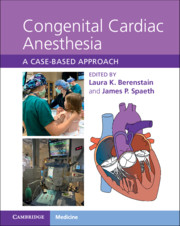Book contents
- Congenital Cardiac Anesthesia
- Congenital Cardiac Anesthesia
- Copyright page
- Dedication
- Contents
- Contributors
- Introduction
- Chapter 1 A Congenital Heart Disease Primer
- Section 1 Left-to-Right Shunts
- Section 2 Right-Sided Obstructive Lesions
- Section 3 Left-Sided Obstructive Lesions
- Section 4 Complex Mixing Lesions
- Section 5 Single-Ventricle Physiology
- Section 6 Heart Failure, Mechanical Circulatory Support, and Transplantation
- Chapter 31 Duchenne Muscular Dystrophy
- Chapter 32 Dilated Cardiomyopathy
- Chapter 33 Mixed Cardiomyopathy
- Chapter 34 Extracorporeal Membrane Oxygenation
- Chapter 35 Left Heart Ventricular Assist Device
- Chapter 36 Right Ventricular Assist Device
- Chapter 37 Lung Transplantation
- Chapter 38 Post Orthotopic Cardiac Transplantation
- Chapter 39 Failing Cardiac Transplant
- Section 7 Miscellaneous Lesions and Syndromes
- Index
- References
Chapter 34 - Extracorporeal Membrane Oxygenation
from Section 6 - Heart Failure, Mechanical Circulatory Support, and Transplantation
Published online by Cambridge University Press: 09 September 2021
- Congenital Cardiac Anesthesia
- Congenital Cardiac Anesthesia
- Copyright page
- Dedication
- Contents
- Contributors
- Introduction
- Chapter 1 A Congenital Heart Disease Primer
- Section 1 Left-to-Right Shunts
- Section 2 Right-Sided Obstructive Lesions
- Section 3 Left-Sided Obstructive Lesions
- Section 4 Complex Mixing Lesions
- Section 5 Single-Ventricle Physiology
- Section 6 Heart Failure, Mechanical Circulatory Support, and Transplantation
- Chapter 31 Duchenne Muscular Dystrophy
- Chapter 32 Dilated Cardiomyopathy
- Chapter 33 Mixed Cardiomyopathy
- Chapter 34 Extracorporeal Membrane Oxygenation
- Chapter 35 Left Heart Ventricular Assist Device
- Chapter 36 Right Ventricular Assist Device
- Chapter 37 Lung Transplantation
- Chapter 38 Post Orthotopic Cardiac Transplantation
- Chapter 39 Failing Cardiac Transplant
- Section 7 Miscellaneous Lesions and Syndromes
- Index
- References
Summary
A congenital diaphragmatic hernia is a rare birth defect characterized by a diaphragmatic defect allowing herniation of abdominal contents into the chest, subsequently impeding normal lung development. This results in structural and functional changes to lung structure, pulmonary circulation, and the heart. The size of the defect can significantly affect the prognosis, as the severity of this condition is proportional to the severity of lung hypoplasia and pulmonary hypertension. Initiation of extracorporeal membrane oxygenation is considered a last resort, life-preserving option for neonates with congenital diaphragmatic hernia who have failed all other medical therapies. This chapter details the management of an infant with congenital diaphragmatic hernia, currently on extracorporeal membrane oxygenation support and requiring repair of his hernia.
Keywords
- Type
- Chapter
- Information
- Congenital Cardiac AnesthesiaA Case-based Approach, pp. 261 - 267Publisher: Cambridge University PressPrint publication year: 2021

